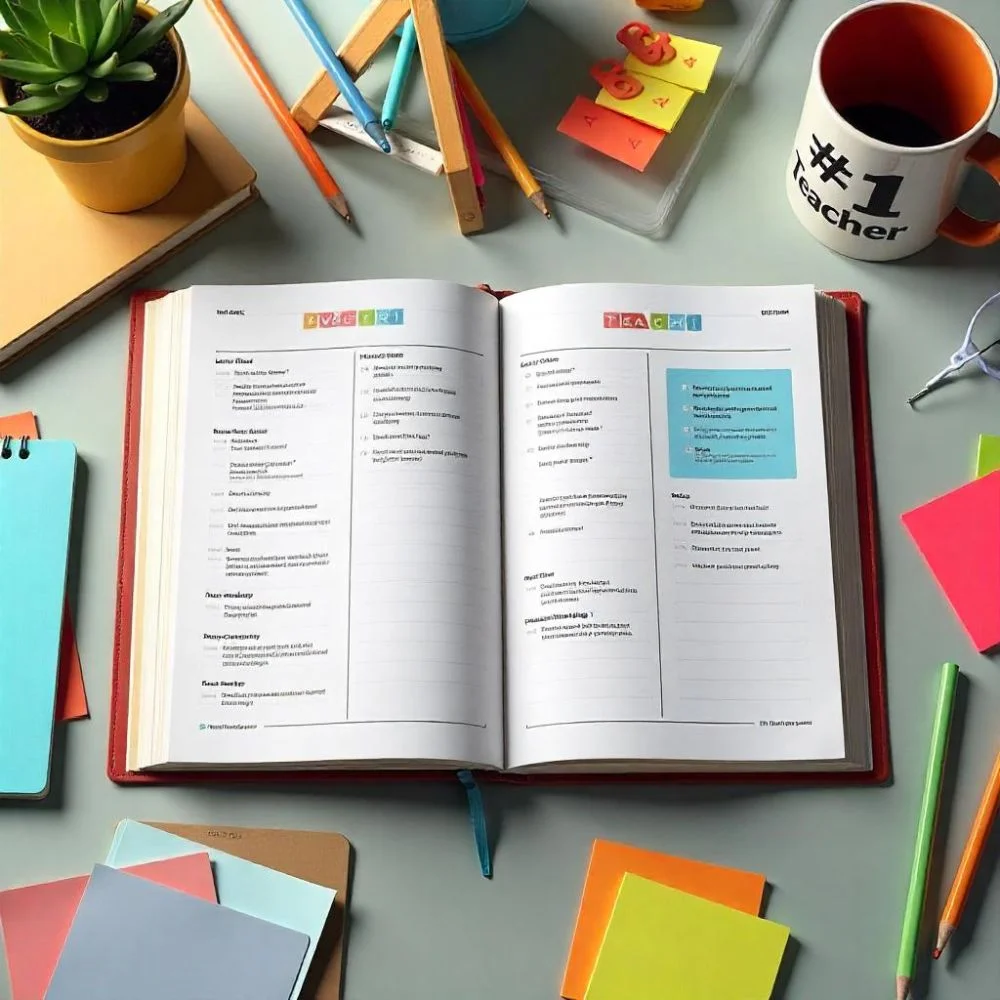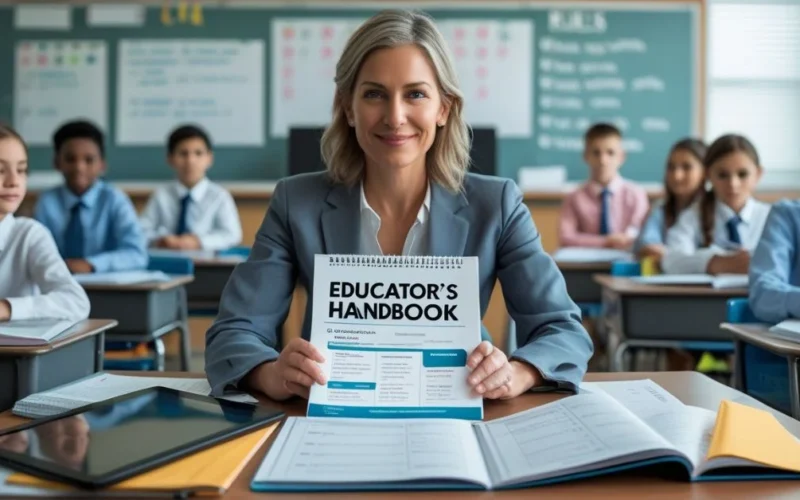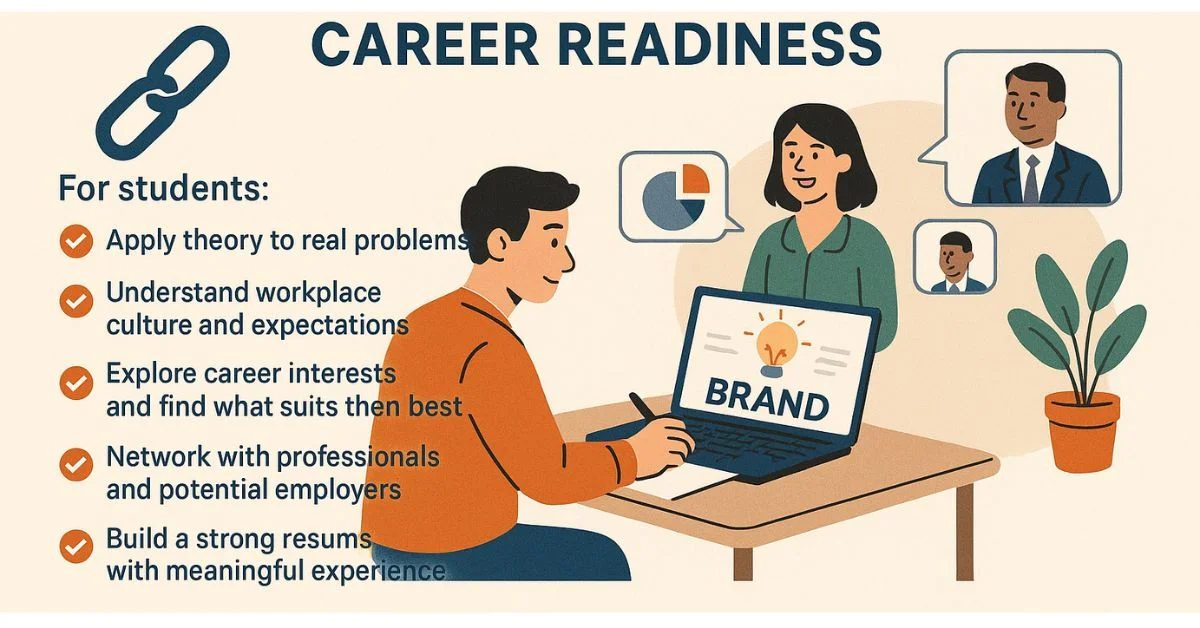Table of Contents
- What Is an Educator’s Handbook?
- Why Every Teacher Needs an Educator’s Handbook?
- Main Sections of an Educator’s Handbook
- How does the Educators Handbook help with Lesson Planning?
- Improving Classroom Management with a Handbook
- Enhancing Teacher-Student Relationships Through the Handbook
- Technology Tips in the Modern Educators Handbook
- Supporting Teacher Growth with the Educators Handbook
- How Schools Customize the Educator’s Handbook?
- Tips for Using the Educator’s Handbook Effectively
- FAQs
- Conclusion
What Is an Educator’s Handbook?
A brief look at what this guide is and how it supports teaching. An educator’s handbook is a teaching manual that includes school policies, classroom strategies, discipline rules, and teaching tips. It is a go-to resource for both new and experienced teachers. This handbook makes the job of teaching easier by offering structure and ready solutions for common classroom challenges.From planning lessons to handling student behavior, it covers it all in one place.
Why Every Teacher Needs an Educator’s Handbook?
Understand why this guide is necessary for effective teaching. Every teacher faces daily decisions and unexpected classroom situations. The educator’s handbook helps simplify these challenges. It outlines how it supports daily teaching tasks and why it is a must-have tool for both new and experienced educators.
Benefits include:
- Clarity on school rules and responsibilities
- Ready-to-use teaching frameworks
- Guidance on student engagement
- Discipline management methods
- Greater confidence in the classroom
With a handbook, teachers save time, stay consistent, and maintain control.
Main Sections of an Educator’s Handbook

This heading outlines the common areas covered in the guide. A strong educator’s handbook includes everything a teacher needs to handle their responsibilities. This heading lists and explains the core parts found in a typical handbook, like lesson planning, classroom rules, discipline policies, and teacher behavior guidelines. It shows the structure and contents of the guide.
Here are the core sections:
1. Lesson Planning Guidelines
- Helps design daily, weekly, and term-long lessons
- Aligns content with learning goals
- Includes examples of structured lessons
2. Classroom Management Strategies
- Offers tips for maintaining order
- Explains how to set clear rules and expectations
- Promotes fairness and control without stress
3. Student Discipline Policies
- Details on handling misbehavior
- Encourages fair consequences and warnings
- Guides communication with parents
4. Professional Behavior Expectations
- Sets standards for communication, attire, and ethics
- Encourages respectful staff and student relations
- Builds teacher-student trust
How does the Educators Handbook help with Lesson Planning?
Explore how the handbook supports structured and effective lessons. Planning lessons can feel overwhelming. The educator’s handbook provides step-by-step instructions to create balanced and engaging lesson plans. This heading focuses on how the handbook supports teachers in designing strong lesson plans. It gives examples of planning methods, helping teachers stay on track with the curriculum.
It helps teachers:
- Set learning targets clearly
- Organize subjects across timelines
- Use worksheets, group tasks, and visual aids effectively
This keeps students involved and learning on track.
Improving Classroom Management with a Handbook
Learn how to use the handbook to manage student behavior with ease. Managing a room full of students needs more than just rules. The educator’s handbook explains how to build a respectful and well-structured classroom. This section highlights how the handbook provides useful strategies for managing student behavior and keeping a productive classroom environment.
It helps with:
- Setting consistent expectations
- Handling disruptions calmly
- Creating a seating plan
- Encouraging student participation
- A stable environment allows students to focus better and teachers to teach without stress.
Enhancing Teacher-Student Relationships Through the Handbook
Strong relationships build better classrooms. Here’s how the handbook helps. The educator’s handbook is not only about rules and lesson plans. It also focuses on the emotional and social side of teaching, how teachers interact with students in a respectful, understanding, and fair way. A strong teacher-student relationship creates a safe and positive learning space. When students feel valued and heard, they behave better, try harder, and enjoy learning more.
It suggests techniques like:
- Active listening
- Fair discipline without shouting
- Respecting student diversity
- Giving regular feedback
These methods create an atmosphere where students feel valued and motivated to learn.
Technology Tips in the Modern Educators Handbook

Modern handbooks include digital teaching support; see how it works. Today’s classrooms use smartboards, tablets, and online tools.
The educator’s handbook now includes digital strategies that help teachers stay current. This section focuses on how newer versions of the handbook include digital teaching tools, helping teachers stay modern and tech-savvy.
It offers guidance on:
- Using educational apps and e-learning tools
- Assigning and checking online homework
- Tracking attendance or test scores digitally
- Using digital safety guidelines
With these tools, teachers can mix traditional and modern techniques effectively.
Supporting Teacher Growth with the Educators Handbook
Beyond the classroom, the handbook also supports career development. A great educator’s handbook doesn’t stop at teaching advice it also helps teachers grow. This heading explains how the handbook promotes career development, reflection, and professional improvement over time.
It includes:
- Professional development goals
- Links to workshops or certifications
- Performance review tips
- Peer feedback techniques
This supports long-term improvement and helps teachers move forward in their careers.
How Schools Customize the Educator’s Handbook?
Every school is different: learn how they tailor the guide. Each school has its unique culture and policies. The educator’s handbook is often customized to reflect those values. This heading explains that not all handbooks are the same. Schools may adjust them based on their mission, policies, culture, or legal requirements.
Custom elements may include:
- School vision and mission
- Rules for uniforms and attendance
- Religious or cultural considerations
- School-specific emergency procedures
This makes the handbook truly useful and aligned with the school’s needs.
Tips for Using the Educator’s Handbook Effectively
Learn smart ways to make the most of this teaching tool. Just having a handbook isn’t enough. Teachers must use it the right way. This section gives practical suggestions to help teachers get the most out of the handbook. It encourages active daily use and smart reading habits.
Practical tips:
- Read it before the school year starts
- Keep a copy on your desk or digital device
- Bookmark important sections
- Use it during lesson planning
- Refer to it during difficult student situations
Using it daily makes teachers more confident and organized.
FAQs
Common questions teachers ask about this essential guide.
Q1: Who prepares the educator’s handbook?
Usually, school management or education boards prepare it. It may also involve experienced teachers and policymakers.
Q2: Can teachers give feedback on the handbook?
Yes. Many schools ask teachers for feedback to improve the handbook each year.
Q3: Is the educator’s handbook only for new teachers?
No. It is helpful for both new and experienced teachers. Even senior staff refer to it for updates or clarification.
Q4: Can the handbook be digital?
Yes. Most schools now provide a digital version to make it easier to access from phones or computers.
Q5: How often is the handbook updated?
It is usually reviewed yearly or when school policies change.
Conclusion
The educator’s handbook is more than just a rulebook or instruction manual; it is a complete support system for teachers at every stage of their career. It provides clear steps to plan lessons, manage classrooms, handle discipline, and grow professionally. Whether you are a new teacher trying to find your footing or a seasoned educator looking to stay organized, this guide helps you stay focused, confident, and consistent.








